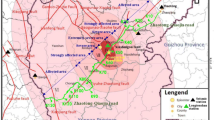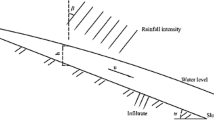Abstract
China is a country with frequent landslide disasters, especially in Western China. Chongqing Wulong County Yangjiao landslide is taken as the engineering background. Three-dimensional elastic constitutive model is used to calculate the soil aggregate landslide’s overall stability and landslide stability analysis of deformation and failure process disintegration. Combined with engineering practice of gravel soils under the action of rainfall of the landslide collapse deformation failure process analysis, the main failure mechanism of landslide deformation is revealed under the action of rainfall. Combined with the geographical position of the landslide and the effects of the earthquake, the coupling model of the earthquake and rainfall is established. The stability of the landslide in the earthquake and strong rainfall is analyzed. The results show that the landslide deformation and failure are affected more significantly by the slope morphology, and the landslide has a significant amplification effect of seismic waves.







Similar content being viewed by others
References
Chen Y, LIU DF, WANG SM, Dong-fang TIAN (2010) Factors for stability of three-dimensional unsaturated soil landslides. Chin J Geotech Eng 32:1236–1240
Chen W, Li WP, Hou EK, Bai HY, Chai HC, Wang DZ, Cui XL, Wang QQ (2014) Application of frequency ratio, statistical index, and index of entropy models and their comparison in landslide susceptibility mapping for the Baozhong Region of Baoji, China. Arab J Geosci (in press)
Deng HF, Li JL, Wang LH, Zhou JF, Deng CJ (2010) 3D finite element analysis of reservoir bank landslide based on strength reduction method. Rock Soil Mech 31:1604–1608
Du ZY, Zhang YX (2012) Numerical research on the effect of thermal disturbance on soil temperature fields around wells of vertically buried single-U-tube ground heat exchanger. J Conver Info Technol 7:383–391
Fahimifar A, Abdolmaleki A, Soltani P (2014) Stabilization of rock slopes using geogrid boxes. Arab J Geosci 7:609–621
Gao X, Gu ZQ (1997) The application of artificial water curtain to unlined gas storage caverns. Chin J Rock Mech Eng 16:178–187
Lee YN, Yun SP, Kim DY, Nam HK (1996) Design and construction aspects of unlined oil storage caverns in rock. Tunn Undergr Space Technol 11:33–37
Lee YN, Suh YH, Kim DY, Jue KS (1997) Stress and deformation behaviour of oil storage caverns during excavation, International Journal of Rock Mechanics and Mining Sciences ISRM International Symposium 36th U.S. Rock Mech Symp 34:301–305
Nie L, Li ZC, Zhang M, Xu LN (2014) Deformation characteristics and mechanism of the landslide in West Open-Pit Mine, Fushun, China. Arab J Geosci (in press)
Sarkar K, Singh TN, Verma AK (2012) A numerical simulation of landslide-prone slope in Himalayan region—a case study. Arab J Geosci 5:73–81
Shooshpasha I, Amirdehi HA (2014) Evaluating the stability of slope reinforced with one row of free head piles. Arab J Geosci (in press)
Srikrishnan S, Porathur JL, Agarwal H (2013) Impact of earthquake on mining slopes—a numerical approach. Arab J Geosci (in press)
Sturk R, Stille H (1995) Design and excavation of rock caverns for fuel storage-a case study from Zimbabwe. Tunn Undergr Space Technol 10:193–201
Topsakal E, Topal T (2014) Slope stability assessment of a re-activated landslide on the Artvin-Savsat junction of a provincial road in Meydancik. Arab J Geosci (in press)
Xu XH, Shang YQ, Wang YC (2011) Comprehensive treatment and evaluation decision method of gravel soil landslide. J Jilin Univ 41:484–492
Yang G, Yang Q, Liu WH, Zhang K (2012) Critical cyclic stress ratio of reconstituted silty clay under the cyclic loading. J Conver Info Technol 7:1–8
Yang TH, Shi WH, Wang PT, Liu HL, Yu QL, Li Y (2014) Numerical simulation on slope stability analysis considering anisotropic properties of layered fractured rocks: a case study. Arab J Geosci (in press)
Zhang ZG, Tan ZS, Wan JL, Zhang HR (2003) Three-dimensional seepage analysis of underground LPG storage with water curtain. ChinJ Geotech Eng 25:331–335
Zhang Y, Xu WY, Shi C, Wang RB, Sun HK (2011) Three dimensional numerical analysis of stability of large scale landslide accumulation body. Rock Soil Mech 32:3487–3496
Author information
Authors and Affiliations
Corresponding author
Additional information
Highlights
•Elastic constitutive model or elasto-plastic constitutive model are popularly used by many researchers; however, fluid solid coupling model is rarely used. The coupling model of the earthquake and rainfall is established.
•Hydrodynamics and hydrodynamics are mixed into one model.
Rights and permissions
About this article
Cite this article
Yang, Sy., Li, Sc., Xue, Yg. et al. Study of stability of large landslide considering fluid solid coupling. Arab J Geosci 9, 35 (2016). https://doi.org/10.1007/s12517-015-2113-z
Received:
Accepted:
Published:
DOI: https://doi.org/10.1007/s12517-015-2113-z




